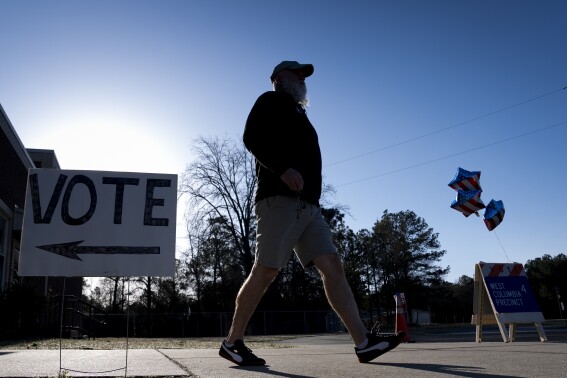Ukraine War Maps Show Key Battles of Last 2 Years
Two years of Russia's full-scale war on Ukraine have left more than 100,000 dead, Ukraine's landscape scarred across 900 miles of front line, and cities in the east of the country effectively wiped off the map.
The return of a major conflict to Europe is reshaping the security balance on the continent and beyond. As European NATO powers warn that a direct war with Moscow is no longer unthinkable, Western leaders are simultaneously seeking to bolster Kyiv and—more privately—envisioning a way for the fighting to stop.
For all the death and devastation, there have been few territorial changes since November 2022. The first phase of the war was characterized by relatively fluid, large-scale movement. Russia tried and failed to collapse the Ukrainian state, reaching the outskirts of Kyiv, Kharkiv, and approaching Odesa.
Kyiv's subsequent counteroffensive liberated swathes of the south and northeast. But since then, the war has settled into a brutal rhythm of attrition, any advance for either side small and at great cost.
Ivan Stupak, a former officer in the Security Service of Ukraine (SBU) and now an adviser to the Ukrainian parliament's national security, defense and intelligence committee, told Newsweek that many Ukrainians "are tired" after two years of war.
"The situation is not normal, but it's not the end of the world," he added, noting the dark periods of early 2022 when the existence of the state was under threat, and 2023 when Russia's bombardments threatened the national grid and economy.
Millions of refugees are still waiting to return home, while national infrastructure is ravaged. "We have to stop this war, we have to reconstruct, to rebuild," Stupak said.
For now, at least, combat will continue, with neither side open to concessions but the Ukrainians appear on the backfoot.
"Doom and gloom is definitely there," Mark Voyger—a former special adviser for Russian and Eurasian affairs to then-commander of U.S. Army Europe General Ben Hodges—told Newsweek from the Ukrainian capital.
Kyiv and its allies are experiencing a "very hard reality check," Voyger, now the vice president at the American University Kyiv, added. "Unfortunately, Ukrainians are paying once again with the blood of their soldiers and tears of their civilians."
The Battle of Kyiv
President Vladimir Putin's Ukraine gambit began with a high-stakes drive for the capital. The so-called "thunder run" saw forces drive south from Belarus, as helicopter-borne elite Russian paratroopers sought to capture the Hostomel airport on the outskirts of Kyiv. Ukrainian forces were waiting, having been warned of the operation by U.S. intelligence.
Russia lost the battle of Kyiv, its forces bogged down in the city's outskirts—where Russian troops spent weeks brutalizing residents—awaiting the arrival of a 40-mile long supply convoy from Belarus. Sabotage and assassination teams dispatched into Kyiv failed to find leaders or collapse Ukrainian will to resist.
President Volodymyr Zelensky emerged as an international symbol of resistance during this battle. "I need ammunition, not a ride"—the president's supposed response to a U.S. offer to evacuate him from Kyiv—will go down in Ukrainian history.
Russian forces abandoned the northern axis in late March, framing the decision to retreat as a "goodwill gesture." But the horrors left behind by Moscow's units fatally undermined the fractious peace talks that began in the hours following the Russian invasion on February 24. "We will never forgive," Zelensky said in March 2023.
The five-week battle punctured the myth of Russian military might. It showed Western allies that Ukraine would not collapse, and that its armed forces—and its people—would fight. Ukraine's unexpected victory helped create a new, steeled national identity and confidence, which Kyiv would carry through to the next stage of the war.
Surprises in Kharkiv, Kherson
Fall 2022 brought stunning Ukrainian success, its commanders masterminding dual offensives that liberated Kherson in the south and much of the Kharkiv region in the northeast. The former had been expected for some time, but the Kharkiv push was a surprise operation that collapsed Russian lines and liberated some 400 square miles.
Coming so soon after victory around Kyiv, the fall 2022 campaign prompted a buoyant mood in Ukraine and among its Western partners. Russia's military appeared to be in disarray, and Putin began mobilizing hundreds of thousands of Russians to plug the gaps in the front line—though tens of thousands responded by fleeing the country.
The months after, though, would see Russian forces dig in all across the front. General Sergey Surovikin, then the commander of the invasion, oversaw the construction of the so-called "Surovikin Line" that would eventually stymie Ukraine's next major offensive operation.
The fate of both Kherson and Kharkiv speaks to the relentless nature of the war. Residents of both were jubilant following the fall 2022 advances, but both have remained under regular Russian bombardment since.
Donetsk Grind: Bakhmut-Avdiivka
The dynamic battles of 2022 gave way to a grinding 2023. The battles of the eastern Donetsk front—particularly those for Bakhmut and Avdiivka—embodied this attritional character, with dug-in Ukrainian troops on the defensive against massed Russian infantry assaults—some led by Wagner Group mercenaries and augmented by so-called Storm-Z penal units.
The plodding and bloody offensives destroyed the objectives themselves. The approach has become the standard for Russian forces following the failure of the more ambitious spring 2022 effort.
What was left of Bakhmut fell in May 2023, and Avdiivka in February 2024. Russia paid a massive human price for the victories but also inflicted serious losses on the Ukrainian defenders. Kyiv's soldiers described the battles as "hell."
Kyiv's stated intention was to bleed the Russians. That it has done, but the trade-off in Ukrainian lives was demoralizing. In Avdiivka's case, the shortage of Western munitions played a key part in the Ukrainian decision to retreat.
This collective failure of Western partners may speak to a concerning fatigue among the allies that Kyiv's war effort so needs.
"We assumed too much by giving too little to the Ukrainians," Mark Voyger told Newsweek from the Ukrainian capital. "We assumed that they would achieve quick and easy victory because of their resilience, superior fighting capabilities, morale, etc.; all those psychological, non-tangible assets or qualities.
"We fell behind, whether by neglect, by design, or because of fears of nuclear escalation and Russia's psychological and information operations. Ultimately, we fell short."
A Disappointing Counter
Ukraine's summer 2023 counteroffensive was similarly demoralizing for Kyiv and its Western backers. Much touted, the operation was the first to utilize the main battle tanks supplied by NATO partners. But delays to their delivery and a lack of supporting munitions meant Kyiv delayed the attack, giving Russian forces time to fortify the entire defensive line.
Ukrainian units pushed for several months, only managing to carve out a small salient on the Zaporizhzhia front and minimal gains around the flanks of Bakhmut in the east, all at high human cost.
The offensive sputtered into stalemate with the onset of winter 2023. "There is not enough power to achieve the desired results faster," Zelensky said then. "But this does not mean that we should give up, that we have to surrender."
"We are losing people, I'm not satisfied. We didn't get all the weapons we wanted, I can't be satisfied, but I also can't complain too much."
But for all Zelensky's resolve, the failure of the 2023 counteroffensive has prompted renewed talks of potential peace talks between Kyiv and Moscow. Western partners have long publicly committed to following Ukraine's lead, but in private, conversations continue as to how the war can end.
Politico reported in December that U.S. officials had begun focusing on empowering Ukraine in future peace talks, rather than simply ensuring Ukrainian victory. "That's been our theory of the case throughout—the only way this war ends ultimately is through negotiation," an anonymous White House official told the publication. "We want Ukraine to have the strongest hand possible when that comes."
Some foreign policy luminaries are openly pushing for such a development. Richard Haass and Charles Kupchan of the Council on Foreign Relations—both of whom have reportedly been involved in unofficial back-channel U.S.-Russia discussions—told Newsweek at the end of 2023 that time was not on Kyiv's side.
"Good strategy is about not just what's desirable, but also what's possible," Kupchan said then. Haass added that full Ukrainian territorial liberation will "probably have to wait on the emergence of a post-Putin leadership, or a post-post-Putin leadership."
"Our prospects are not so bright," Stupak said. "What are the steps in this war? I don't clearly understand. What about a counteroffensive in 2025? It doesn't sound realistic."
This year is expected to be a grind. "I very much hope they surprise not only us but the Russians," Voyger said of Ukrainian forces. Still he stressed, "defensive measures absolutely have to be undertaken."
The 'Inhospitable Sea'
While the ground war sclerosed, the battle for control of the Black Sea—once called the "Inhospitable Sea" by the ancient Greeks—delivered repeated surprises. Ukraine has no conventional navy of note, but its maritime innovation has forced Moscow's feared Black Sea Fleet onto the back foot regardless.
Around a fifth of Russia's pre-war Black Sea Fleet has been sunk since February 2022, per estimates from Ukraine and its Western partners. The first scalp was the Black Sea Fleet's flagship, the guided missile cruiser Moskva, sunk in April 2022 after being hit by two Ukrainian anti-ship missiles.
Things have only deteriorated for the Russian navy since then. Naval drones and anti-ship missiles have made the southern Ukrainian coast a no-go zone for Russian warships, while the arrival of Western cruise missiles—primarily the British-French Storm Shadow/SCALP—has allowed Kyiv to repeatedly hit the Black Sea Fleet's home base of Sevastopol.
The repeated strikes even reportedly forced Moscow to withdraw some of its most valuable vessels to safer ports in Russia's Novorossiysk—which has also been targeted by Ukraine's naval drones—and elsewhere.
Along with the Moskva, Moscow has also lost multiple Ropucha-class landing ships, the Rostov-on-Don attack submarine, and the Tarantul-class Ivanovets missile corvette. Important dry dock infrastructure was destroyed in Sevastopol, while the Kerch Strait Bridge was damaged by naval drones.
"The Black Sea has really been the success story of this whole bungled strategic operation to provide Ukraine with everything they needed," Voyger said.
"Russia did what they often do. They also grew complacent, and they assumed that they had naval superiority," Voyger added. "If everyone expected the victory on land, in fact the victory has been at sea."
Newsweek has contacted the Russian Defense Ministry by email to request comment.
Disclaimer: The copyright of this article belongs to the original author. Reposting this article is solely for the purpose of information dissemination and does not constitute any investment advice. If there is any infringement, please contact us immediately. We will make corrections or deletions as necessary. Thank you.




